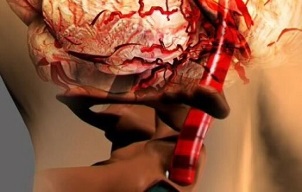
Signs of osteochondrosis of the cervical spine can occur at any age. Most often, this disease occurs in the elderly, and not only lesions on the neck can be observed. However, at present there is an exacerbation of dystrophic processes in the neck in young people who are mainly engaged in mental work. It should be understood that it is very difficult to completely cure cervical osteochondrosis, but you can stop its progression and significantly improve the well-being of a person.
Reasons and mechanism of formation
Cervical dystrophic processes start slowly. The most important causes of the disease are a sedentary lifestyle and violations of certain types of mineral metabolism.
If you eliminate the causes that provoked osteochondrosis of the neck, then it will be quite possible to cure some of its manifestations. Otherwise, if the action of the cause continues, the condition of the person will only worsen.
Under the influence of the root cause that caused the osteochondrosis of the neck, the following changes occur:
- the starting point is congestion of the lymphatic and circulatory system;
- then there are degenerative-destructive changes in the intervertebral disc, which acts as a shock absorber between the vertebrae; its height and plasticity decrease;
- a little later there are growths of bone tissue from the vertebrae;
- all of this leads to limited mobility of the spine, increased pressure on the vessels and nerves passing through the bony apparatus of the spine.

The sooner the correct treatment is started, the greater the chances of slowing the progression of the disease and even curing the person completely.
An exacerbation of the disease can be caused by any external or internal influence. It could be a viral infection, a cold temperature, heavy physical activity, or even spikes in air pressure. The stronger the cause of the exacerbation, the more pronounced the signs of the disease.
Features of cervical osteochondrosis
Signs of cervical osteochondrosis develop gradually, at the very onset of the disease they practically do not bother the patient. Dizziness can only be noted occasionally. However, cervical osteochondrosis cannot be ignored: the symptoms in the advanced stages of the disease are difficult to eliminate.
Since the cervical spine is directly connected to the brain, if there are degenerative changes in that particular area, many complaints from the central nervous system will be noted. This is due to a gradual and increasing deterioration of blood circulation and metabolic disorders in the brain.
In many patients, symptoms suggestive of brain damage may first be observed:
- sudden changes in blood pressure;
- dizziness;
- burning in the temporal region and diffuse headache;
- the temperature rises less often at low values.
In combination with the above symptoms, there are signs of damage to the neck itself:
- pains that eventually radiate to the back, arms, back of the head;
- limitation of mobility, when tilting and / or rotating the head, a sensation of crackling, cracking, numbness or burning is felt in the neck; Body temperature
- is normal.
As osteochondrosis progresses, the condition of the person will worsen, the exacerbation will occur more often and stronger, it will be very difficult to heal a person completely over time, it will notit will be possible to alleviate only a little his suffering.
Unlike inflammatory processes, the temperature rarely changes. In the later stages of osteochondrosis of the neck, the exacerbation practically does not go away, there will be a combination of serious damage to the brain and spine:
- high blood pressure jump or persistent high blood pressure;
- constant dizziness and headache, worse with light exertion;
- pain, burning and limited mobility of the neck;
- body temperature may rise slightly, but more often than not remains normal.

The so-called vertebral artery injury syndrome occurs quite often, when the degenerative-dystrophic process covers the middle of the neck. Such a person almost constantly feels a throbbing headache, pressure and burning in the temples, congestion and tinnitus, turning his head - dizziness and even loss of consciousness. Spinal artery compression syndrome is almost impossible to cure.
In some people, on the contrary, you can observe signs of damage to the upper limbs (with predominant changes in the cervical and brachial plexus):
- burning or numbness in all parts of the upper limbs;
- dizziness is rare;
- decrease in skin temperature.
The consequences of osteochondrosis can be quite serious: persistent headache and dizziness, impaired memory and attention, constant numbness throughout the neck.
Processing methods
Almost complete restoration of the initial state of the osteoarticular apparatus can be achieved only in the early stages of osteochondrosis and after elimination of its cause. An exacerbation of the disease requires even more intensive treatment. In the later stages, the goal of treatment is to relieve pain, dizziness, and inflammatory changes. You can cure cervical osteochondrosis with the help of such means as:
- chondroprotectors to restore the original structure of the cartilage tissue of the intervertebral disc;
- nonsteroidal anti-inflammatory drugs (NSAIDs) for pain and inflammation;
- multivitamin complexes with high content of B vitamins to improve trophism of nervous tissue;
- nootropics for the correction of serious disorders of brain tissue;
- complex of physiotherapy exercises and massage (if severe dizziness and high blood pressure does not occur);
- physiotherapy (water, iontophoresis, magnetotherapy), while the temperature and pressure of the factor should be high enough, and combustion is considered a positive effect.
The treatment of osteochondrosis largely depends on the patient himself. The sooner the necessary treatment is started, the more carefully a person fills in the doctor's prescriptions, the more chances of success and a decent quality of life for the patient.



































